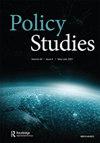新冠疫情期间的政策转移
IF 2.3
4区 管理学
Q2 PUBLIC ADMINISTRATION
引用次数: 1
摘要
政治制度的紧密联系早已成为现实。尽管各国之间从未完全隔绝,但人们普遍认为,随着20世纪的发展,文化、政治、经济和技术联系迅速增加,社会关系越来越多地被描述为“全球化”时代。几十年前,对这种相互联系的认识导致了对政策转移的兴趣的增长。政策转移通常被认为是“一个时间和/或地点的政策、行政安排、制度等知识被用于另一个时间和/或地点的政策、行政安排和制度发展的过程”(Dolowitz和Marsh 1996, 344)。然而,随着社会面临的挑战不断演变,政策转移的理论和实践有机会得到重新审视。政策转移通常是政策研究中提出的分析焦点(Evans 2009;Marsh and Evans 2012;Gauja 2016)和本期的文章遵循了这一传统,其中一些文章侧重于COVID带来的特殊挑战。大流行暴露了另一个全球相互联系轴心的程度,这一轴心没有得到广泛考虑:流行病学。本文章由计算机程序翻译,如有差异,请以英文原文为准。
Policy transfer during the COVID era
The close interconnectivity of political systems has long been the reality. Although states have never been entirely disconnected from one another, cultural, political, economic and technological ties were commonly thought to have rapidly increased as the twentieth century progressed and societal relations were increasingly described as an era of “globalisation”. The recognition of this interconnectivity led to a growth of interest in policy transfer several decades ago. Policy transfer was commonly taken to be “a process in which knowledge about policies, administrative arrangements, institutions, etc. in one time and/or place is used in the development of policies, administrative arrangements and institutions in another time and/or place” (Dolowitz and Marsh 1996, 344). As the challenges facing societies evolve, however, there are opportunities for the theory and praxis of policy transfer to revisited. Policy transfer has often been a focus of analysis which has been advanced in Policy Studies (Evans 2009; Marsh and Evans 2012; Gauja 2016) and articles in this issue follow in this tradition – with some focussing on the particular challenge posed by COVID. The pandemic laid bare the extent of another axis global interconnectedness, one which had not been as widely considered: the epidemiological.
求助全文
通过发布文献求助,成功后即可免费获取论文全文。
去求助
来源期刊

Policy Studies
PUBLIC ADMINISTRATION-
CiteScore
5.40
自引率
4.50%
发文量
34
期刊介绍:
These changes at the structural level of the global system have impacted upon the work of public organizations either directly or indirectly and have broadened the field of action in policy studies. It has five main areas of intellectual interest: 1.To broaden the lens of policy analysis through the publication of research which locates policy-making within a theoretical, historical or comparative perspective. 2.To widen the field of enquiry in policy analysis through the publication of research that examines policy issues in a British, comparative, international or global context. 3.To promote constructive debate on theoretical, methodological and empirical issues in policy analysis.
 求助内容:
求助内容: 应助结果提醒方式:
应助结果提醒方式:


